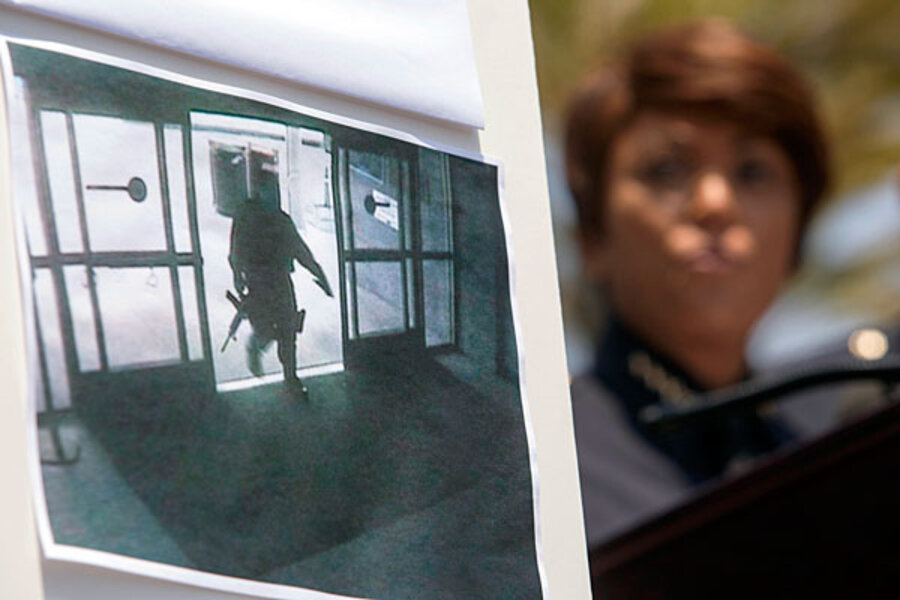Santa Monica shootings: Were gun control laws powerless to stop suspect?
Loading...
Details about John Zawahri, the body-armor clad man who Santa Monica police say killed four people in a shooting spree Friday, are scant. But so far, early reports agree that those who knew Mr. Zawahri believed he was a troubled young man.
Mr. Zawahri had been hospitalized for treatment several years ago after allegedly talking about harming someone, a law enforcement source told CNN on Saturday. The source said Zawahri suffered mental-health issues.
A close friend of the family, who worked with Zawahri's mother, said "John had a fascination with guns. We were all worried about it," according to a Los Angeles Times report.
And one neighbor of Zawahri and his mother, who lived together, told the Times that the mother is "a lovely woman. Petite, sweet, quiet, brunette, and classy – with a crazy kid."
The accounts offer an echo of Newtown, Conn., where a single mother apparently struggled to keep a "crazy kid" in line. There, the mother was the first victim, killed before Adam Lanza went on a his shooting spree, killing 20 first-graders and six staff at Sandy Hook Elementary.
In Santa Monica, Calif., the 23-year-old Zawahri killed his father and brother before fatally shooting three other people on the campus of Santa Monica College, stocked with an arsenal of bullets, a handgun, and an AR-15 semiautomatic rifle, police say. Zawahri was ultimately killed by law enforcement on the campus. Zawahri's mother, Randa Abdou, is reportedly on a one-month vacation in Lebanon.
In the debate over gun control, discussion quickly turns to demagoguery. But Santa Monica, in particular, could stand as evidence of how hard it is to keep guns out of the hands of those who should not have them, even when laws are in place.
In Newtown, Mr. Lanza apparently had ready access to the stockpile of weapons owned by his mother, a gun enthusiast. But there are no reports yet that Ms. Abdou had the AR-15 allegedly used in the massacre Saturday. The Times quotes the Zawahri family friend as saying: "Everyone is wondering where he got the money for the weapons."
Newtown resulted in a flurry of laws nationwide aimed at making it harder for the mentally ill to buy guns. In fact, though the package of nine gun-control bills introduced in the US Senate this spring was ultimately revoked, the aspect that dealt with mental health was one of the two bills that passed. Even the National Rifle Association backed the bill.
“This is a place where people can come together,” Sen. Debbie Stabenow (D) of Michigan told The New York Times in April, speaking of the mental-health bill. “As we’ve listened to people on all sides of the gun debate, they’ve all talked about the fact that we need to address mental-health treatment. And that’s what this does.”
New Jersey and Florida also strengthened regulations regarding gun control and the mentally ill. Last month, the California Senate passed a bill that would establish a 10-year ban on buying weapons for anyone who violated court-ordered mental-health treatment.
Even now, before that bill has passed the Assembly, California has strict guidelines in place regarding gun control and mental illness. Regulations include a prohibition against anyone owning or buying a firearm who "has been adjudicated to be a danger to others as a result of a mental disorder or mental illness."
While the details of Zawahri's case are not yet known and could take the case in a different direction, Friday's massacre clearly does not hit California unawares. In passing the recent bill, California Senate President Pro Tem Darrell Steinberg (D) said: "We all can recite the horrific acts that have occurred in our country over the last year. These bills attempt to respond to those well-publicized tragedies and many more that go unpublicized."
For mental-health professionals, the danger is in going too far and stigmatizing the mentally ill as dangerously violent, which is not true in the vast majority of cases, they say.
"There are mental illness diagnoses that do increase your risk of violence," Josh Horwitz, executive director of the gun control group Coalition to Stop Gun Violence, told US News & World Report. "But identifying which [diagnoses] those are and who those people are is going to be difficult."








